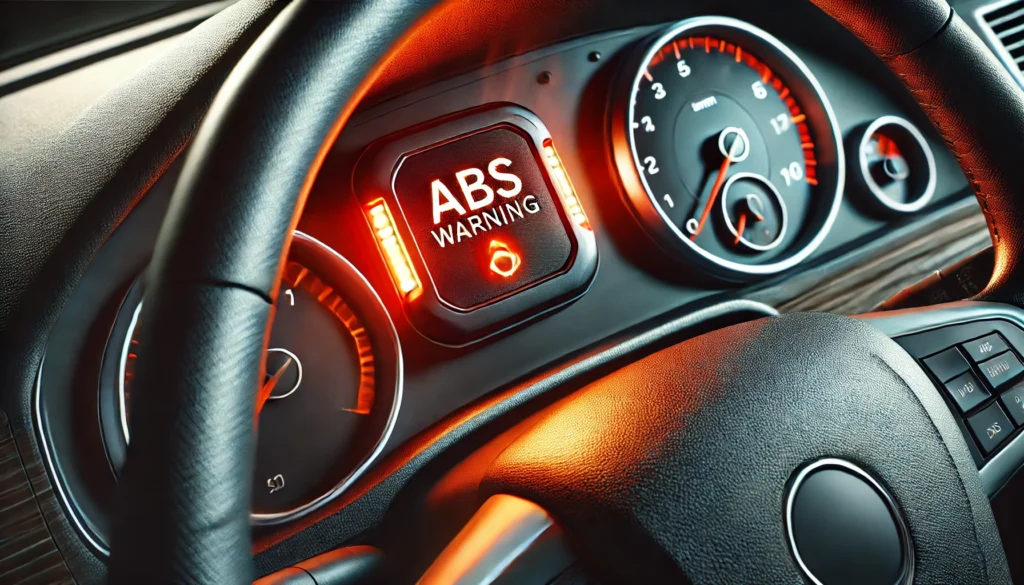When the ABS light on car dashboard lights up, it’s a clear signal that something might be wrong with your vehicle’s Anti-lock Braking System (ABS). The ABS is a critical safety feature designed to prevent your wheels from locking up during braking, especially on slippery surfaces. Understanding what it means when the ABS light turns on and knowing how to address it can save you from potential driving hazards.

What Does the ABS Light on Car Mean?
The ABS light on a car is part of the vehicle’s onboard diagnostic system. When this light comes on, it indicates that the ABS is not functioning correctly. While your regular brakes will still work, the safety feature that prevents wheel lockup and maintains steering control during emergency braking may not.
There are several reasons why the ABS light might come on:
- Faulty Wheel Speed Sensor: Each wheel has a speed sensor that monitors the speed and sends this data to the ABS module. If a sensor is dirty, damaged, or fails, it can send incorrect signals to the ABS, triggering the light.
- Low Brake Fluid: Brake fluid is essential for the proper functioning of the ABS. Low fluid levels can affect the hydraulic pressure in the ABS, leading to a warning light.
- Malfunctioning ABS Module: The ABS module is the system’s brain, processing information from the sensors. If it fails, the ABS system may not function properly, and the light will turn on.
- Blown Fuse: Like all electrical systems in your car, the ABS is protected by a fuse. A blown fuse could disable the system and illuminate the warning light.
- Worn Brake Pads: If your brake pads are excessively worn, they can reduce braking efficiency and potentially trigger the ABS light.
What to Do When Your ABS Light Comes On
- Check the Brake Fluid Level: Low brake fluid is one of the simplest issues to resolve. Check your car’s brake fluid reservoir and top it off if needed. Make sure to use the type of fluid recommended by your vehicle’s manufacturer.
- Inspect the Wheel Speed Sensors: If you are comfortable working on your car, you can inspect the wheel speed sensors yourself. Clean any dirt or debris from the sensors and check for any visible damage. However, if you’re not experienced, it’s best to leave this to a professional mechanic.
- Test the ABS Module: Diagnosing a faulty ABS module requires specialized equipment. If you suspect the module might be the issue, it’s advisable to take your vehicle to a repair shop where they can run a diagnostic scan.
- Check the Fuse: Locate the ABS fuse in your car’s fuse box and inspect it. If it’s blown, replacing it may resolve the issue, but keep in mind that a blown fuse could indicate a deeper electrical problem.
- Consult a Mechanic: If the ABS light remains on after you’ve checked the basics, or if you’re unsure about diagnosing the problem yourself, it’s best to consult a professional mechanic. They can diagnose the issue more accurately and suggest the best course of action.
Why You Shouldn’t Ignore the ABS Light
While your car’s basic braking system will still function with the ABS light on, ignoring it can lead to increased risks. Without a functioning ABS, your car is more likely to skid during hard braking, especially on wet or icy roads. This can lead to loss of control and increases the chances of an accident. Additionally, driving with the ABS light on could cause more significant damage to your braking system over time, leading to more costly repairs.
Conclusion
The ABS light on your vehicle is a warning that shouldn’t be ignored. Whether it’s due to a simple issue like low brake fluid or something more complex like a faulty ABS module, addressing the problem promptly will ensure your vehicle remains safe to drive. If you see the ABS light on, take the necessary steps to diagnose and fix the problem to maintain your vehicle’s braking efficiency and safety.